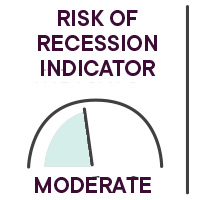Yann Furic
B.B.A., M. Sc., CFA®
Senior Portfolio Manager, Asset Allocation and Alternative Strategies
A difficult month
For stock markets around the world, October was marked by a resurgence of COVID-19 cases in Europe (the anticipated second wave) and the return of partial lockdown measures.
Quarterly corporate results were released and generally beat expectations, but not enough to support stock indexes. The vast majority of economic indicators, however, continue to improve or stabilize, indicating progress of the global economic recovery, albeit at a slower pace.
There is still a lot of uncertainty in the markets. The health crisis and lockdown measures are having very negative effects on certain sectors. The impending expiry of several wage subsidy programs for individuals and businesses could also increase the unemployment rate. Meanwhile, job creation in Canada and the United States once again exceeded expectations.
The U.S. election was held on November 3 and according to the media, Joe Biden is the new president-elect.
Focus on the past month

Overview of global equity markets*
- The flagship index of the Canadian stock market, the S&P/TSX, fell 3.1% in October, for a return of -6.1% for the first ten months of 2020.
- In the United States, the S&P 500 lost 2.5% and the Nasdaq, 2.1%, bringing their returns for the year to 5.6% and 26%, respectively.
- International stock markets were also in negative territory during the month, with the EAFE index declining 3.8% for a year-to-date return of -7.9%.
- Emerging market equities rose 2.3% in October (+3.9% in 2020) and Chinese stocks rose 5.5% (+26.1% in 2020).
* All the percentages in this section are in Canadian dollars. Bloomberg unless otherwise indicated.
Key events

COVID-19: finding a balance
Targeted closures of certain industries (tourism, recreation) around the world are having significant economic repercussions, and governments are trying to support their economies and their workers. Some measures have been renewed in Canada, while in the United States, politicians still cannot come to an agreement, despite calls from the chairman of the U.S. Federal Reserve (Fed) for a new fiscal plan.
As President-elect Joe Biden will not take power until the inauguration of January 20, 2021, the possibility of a fiscal stimulus remains low, except in the event of a significant worsening of the pandemic, which could prompt the U.S. Senate to react.
Key rates at rock bottom
The world’s central banks are maintaining their accommodative monetary policies, and key rates remain at their lowest levels, an ongoing scenario that is providing a slight respite for consumers.
Employment situation
In both Canada and the United States, job creation has exceeded expectations:
- 83,600 jobs in Canada versus expectations of 75,000, reducing the jobless rate from 9% to 8.9%.
- In the U.S., 638,000 jobs versus expectations of 580,000, with an unemployment rate falling from 7.9% to 6.9%
Job creation remains positive, but is decelerating, signaling a slower recovery.
Results – Canadian bonds
Government of Canada bonds across maturities posted a negative return of 0.6% in October. They have risen 6.9% since the start of 2020. (Source: Canaccord Genuity)

Our strategic monitoring
Main risks
Here are some risks that we are closely monitoring in the current environment.
- In the absence of new stimulus, the risk of an economic slowdown remains. The return of widespread lockdown plans in response to a second wave and the decline in consumer confidence could lead to reduced spending in the short to medium term.
- The trade disputes between China and the United States have not been settled and still constitute a risk for the global economy.
Fundamental indicators
Certain economic indicators moved in October.
Consumer confidence ![]()
Consumer confidence is still slightly positive, after many months of weakness.
Global Purchasing Managers’ Index ![]()
The index is over 50, indicating an increase in purchasing managers’ intentions. Overall, most countries are seeing a rise in purchase intentions in the manufacturing sector, but the signals are less evident in the services sector, which has been harder hit by the health crisis.
U.S. retail inventory-to-sales ratio ![]()
This ratio is still at a 15-year low. During the pandemic, the production of many goods was slowed or stopped, while sales continued. The resumption of production to rebuild inventories is a positive sign.
Benchmark rates in Europe and the United States ![]()
Rates remain at low levels, which is favourable for an economic recovery. Central banks are standing by, ready to intervene.
François Landry
CFA®
Vice-President and Chief Investment Officer
Vice-Chairman of the Board of Directors of Professionals' Financial - Private Management
Our strategies
(6-to-12 month horizon)
The financial markets have gained back the ground lost due to the pandemic faster than we expected. Following the result of the U.S. presidential election, with the Democrats winning the presidency and the Republicans holding on to a majority in the Senate, and the drop in interest rates the day after the election, we increased the weight of equities from 55% to 65% and lowered the weight of bonds from 45% to 35%. We believe that over a six to twelve month horizon, equity returns will be higher than bond returns.
There was little change in the geographic allocation of equities in our portfolios.
- The weighting of Canadian equities was slightly increased, with a higher weighting of Canadian banking stocks.
- We are neutral on U.S. equities. We have maintained our exposure to technology stocks and industrials, which should benefit from announced infrastructure spending.
- We are neutral on EAFE (Europe, Australasia, Far East) equities due to the fiscal measures implemented in Europe and the return to partial lockdown of euro zone economies.
- We remain neutral on emerging market equities.
François Landry, CFA
Vice-President and Chief Investment Officer
Yann Furic, B.B.A., M. Sc., CFA
Senior Portfolio Manager, Asset Allocation and Alternative Strategies
Sources: Bloomberg
The opinions expressed here and on the next page do not necessarily represent the views of Professionals’ Financial. The information contained herein has been obtained from sources deemed reliable, but we do not guarantee the accuracy of this information, and it may be incomplete. The opinions expressed are based upon our analysis and interpretation of this information and are not to be construed as a recommendation. Please consult your Wealth Management Advisor.









